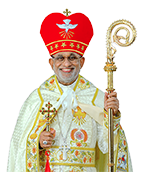





The catechetical heritage of the Syro-Malabar Church is as old as this Church itself. As was the case with all other Churches, among the St. Thomas Christians also there existed a system of catechesis by which faith was handed down from generation to generation. However there is no comprehensive and chronological exposition of the history of catechesis of the Syro-Malabar Church. Hence, many things have to be traced from the historical documents and living traditions of the Church.
The early Church, just after the apostolic period, developed a system of Christian formation or catechesis known as the catechumenate. In this catechumenate, the newcomers were given proper instruction in Christian faith and suitable formation in Christian life and subsequently initiated into the Christian community through the sacraments of initiation. This catechumenate system of Christian formation took different forms and shapes in accordance with the particular context of each Church. As was the case with all other Churches, there was a catechumenate system for the faith formation among the St. Thomas Christians also. But it was not as formal as the catechumenate systems in other Churches.
In the early times of the Church, faith was handed down from one generation to the next mainly through community and family-centered catechesis by means of liturgical celebrations, catechetical instructions, and customary practices. At that time, the catechesis of the St. Thomas Christians was not formal and systematic; it was mainly informal and liturgical. Liturgy was the principal means, mode, and source of catechesis among the St. Thomas Christians. Catechetical instruction was given to adults along with the liturgical celebrations, while children were given special instruction either before or after the Holy Qurbana on the mysteries of faith, and were asked to recite and memorize the basic prayers of the Church. Another means for catechesis was the customary practices of the St. Thomas Christians both in the family and community level. These are the ways by which faith was handed down, preserved, and propagated for centuries among the St. Thomas Christians.
Among the liturgical celebrations, the celebration of Feasts also played an important role in the transmission of the faith. The feasts were usually celebrated both at the community and family level. Of these, the feasts of our Lord such as the Annunciation, the Nativity, the Danaha, the Great Fast, Palm Sunday, Maundy Thursday, Good Friday, Easter, the Ascension, Pentecost, the Glorification of the Cross, etc. were given greater importance than any other feasts. Of the feasts of the Saints, those of St. Mary and St. Thomas were given special importance. The faithful prepared themselves for the feast with fasting and prayer. According to tradition, the Syro-Malabar Church had more than 180 days of fasting. During the days of fast, the faithful abstained from meat, fish, egg, milk products the chewing of betels and conjugal relationship. Such abstinence was observed also on all Wednesdays and Fridays of the year.
The commemoration of the dead was also given special importance. When a person died, his body was washed, dressed and anointed with perfumed oil before it was exposed before the community to pay due homage. Usually, the dead body was placed facing the East. Till the purification of the house after the burial, no food was prepared or eaten in the house. After the burial service, the members of the family would gather in the house in the presence of the parish priest and say special prayers for the dead and sprinkle holy water to purify the house. There were also special observances for the commemoration of the dead on the 7th, 16th, 28th, and 41st day after the demise. The annual ceremony to commemorate the dead is known as sradham or chattam. Till the commemoration on the 41st day only vegetarian meals were served in the house.
During the Holy Week (Great Week), besides the liturgical celebrations in the church, there were also family liturgical celebrations. On the Fridays of the great fast and during the days of the Holy Week the family members would sit together and read the Pana, the passion narrative of the Lord. On Maundy Thursday (Pesaha Vyazham), as a part of the family celebration of the Passover Feast, a special unleavened broad was made in the families. After special prayers, the eldest member of the family would share this bread with the other members of the family. This bread represented the bread used by Jesus during the Last Supper. Together with this, a special drink was also prepared with rice flour, coconut milk, and jaggery which represented the wine of the Last Supper. All these things were done with great respect and reverence. It was patterned after the Jewish mode of celebration of the Passover in the family.
Most of the pious customs and practices of the St. Thomas Christians were biblical. Holy Scripture and the Cross were held in high veneration. Practices like whispering the name of Jesus in the ears of the new born, tying palm leaves with biblical verses to the body of the sick, fixing the sign of the cross on the Tali, (the ornament in the form of a petel worn by the bride in the marriage ceremony), drinking of water mixed with the soil taken from the tomb of St. Thomas at Mylapore by the sick and the dying, lighting of lamps around the foot of the cross in front of the church, etc. are the pious customs among St. Thomas Christians. The customs and ceremonies related to birth and death were also means for the transmission of faith from one generation to the next. The Kathanars who had their training from the Malpans were the main catechists among the St. Thomas Christians. The Ashan Kalaries were also centers for the catechetical instruction for children. Here, the children were taught the fundamental prayers and principles of faith, even by non Christian Ashans.
After the coming of the western missionaries, the catechetical system of the St. Thomas Christians began to develop into a formal and systematic one. In this period the catechism centered catechesis began to gain prominence in the Syro-Malabar Church. Some of the main catechisms used in the Malabar Church before the Synod of Diamper were: the Doctrina Christiana, 1542 (the small catechism prepared by St. Francis Xavier): the Cartilha, 1554 (the first printed catechism for India in Portuguese and Tamil); Doctrina Christam, 1578 (the catechism printed in Tamil at Quilon); The Doctrina Christam, 1579 (the catechism published from Cochin); etc
The Synod of Diamper (1599) further reformulated and systematized the catechetical systems among the St. Thomas Christians in accordance with the direction of the Council of Trent (1545-1562). The informal way of handing down the faith was changed to a formal and systematic one, and the liturgy-centered catechesis was changed to an instruction-oriented one. After the Synod of Diamper (1599), Archbishop Menezis also prepared a catechism known as Menezian Catechism and he insisted that every parish of the Malabar Church should have a copy of this catechism. In the eighteenth decree of the eighth session of the synod of Diamper, some guidelines for catechesis of the Malabar Church are given. The parish priests were asked to teach the people catechism by reciting the prayers and articles of faith. They were asked to teach the people the sign of the Cross the Our Father the Hail Mary the Creed, the Ten Commandments of God the Commandments of the Church, the Articles of faith and other essential items of the catechism. Instead of teaching catechism in Syriac, the priests were asked to doo it in Malabar, the vernacular. The priests were asked to give special instructions to the people young and adults on Sunday by using the method of repeated recitation. They were also asked to conduct catechism classes exclusively for the children on Sunday evenings. These mandatory regulations of the Synod of Diamper contributed much to the systematic development of the catechetical system of the Syro-Malabar Church.
In 1606, Archbishop Ros reformulated the Menezian Catechesis and issued new statutes on catechesis. Tn 1700,the Carmelite Missionaries published a catechism known as Catechismus Doctrinae Christanae in Lingua Malabarica. Then, in 1772 they published a new catechism know as Samkshepa Vedartham which is the first printed book in Malayalam. By the beginning of 20th century, in 1917, came the Valiya Vedopadesham which is the translation of the Catechism of Pope Pius X and the Cheriya Vedopadesham which is the shortened from of the Valiya Vedopadesham. These catechisms prevailed in the Syro-Malabar Church until the Second Vatican Council.
An important development during the first half of the 20th century is the introduction of catechesis in the regular schools. The Catholic Bishops' took great interest in the catechesis for the regular schools. As a result special catechetical instruction for the Catholic students in the regular schools was started. In 1940, a text book series named Matha Tathwa Bodhini was published for the school catechism. Later, moral education was introduced for the non Catholic students in the regular schools. At present, the system of catechism for the Catholic students and moral education for the non Catholic students is in practice in most dioceses, while in some, instead of catechism, only moral (value) education is given to all the students of the school irrespective of religion.
After the Second Vatican Council, there took place radical developments in the field of catechesis. At the all India level, under the guidance of the CBCI (Catholic Bishops' Conference of India), the N.B.C.L.C. (National Biblical Catechetical and Liturgical Centre, Bangalore) gave leadership to develop a catechism text book series for all the dioceses of lndia. Later, the regional Episcopal councils also developed catechisms in their own vernacular languages, which are more relevant to their particular needs and culture. In Kerala, the P.O.C. (Pastoral Orientation Centre), under the guidance of the K.C.B.C. (Kerala Catholic Bishops' Council) in 1970 prepared a common text book series for all the three Catholic Churches of Kerala.
The first common text book series published by the KCBC Catechetical Commission is known as Pithavin Pakkalecku (Towards the Father). After a period of experiment and experience they decided to publish a new series of catechism texts called Kristhuvinte Pinnale (in the Foot Steps of Christ). This was published during the period 1980-1983. Although this system of common catechism text books for all the three Churches contributed in some way to foster unity among the Catholic Churches in Kerala, one serious drawback of this catechetical series was that it could not pay sufficient attention to the particular characteristics and traditions of the individual Churches. In between, a catechetical series named Deivam Nammodukoode (God with Us) was prepared and published by the Inter-eparchial Catechetical Committee of Changanassery.
From 1968 to 1999, the KCBC was in charge of the Catechism for the Kerala Catholic Church. However, in the meeting held in January 1999, the KCBC, having taken into account the mind of the Universal Church and following the provisions in the Code of Canons of the Eastern Churches (CCEO 621 & I, 621 & 3) decided to entrust the responsibility of catechesis to the catechetical commission of each of the Individual Churches. Thereby, the catechetical commission of the Syro-Malabar Church became responsible for the co-ordination and animation of the catechetical ministry of the Syro-Malabar Church.
A person who is either born in or made a member of a particular Church has to be given formation in the traditions of that particular Church. He/She should see, hear, touch and experience the way of life of that particular faith community. He/She should be introduced to and integrated into the liturgy, spirituality, discipline, and customs of the particular Church. The Syro-Malabar Church being a sui juris Church in the Catholic communion should have a catechesis of its own in order to integrate the faithful into the particular traditions of this Church. Now the Synodal Commission for Catechesis is trying for this.